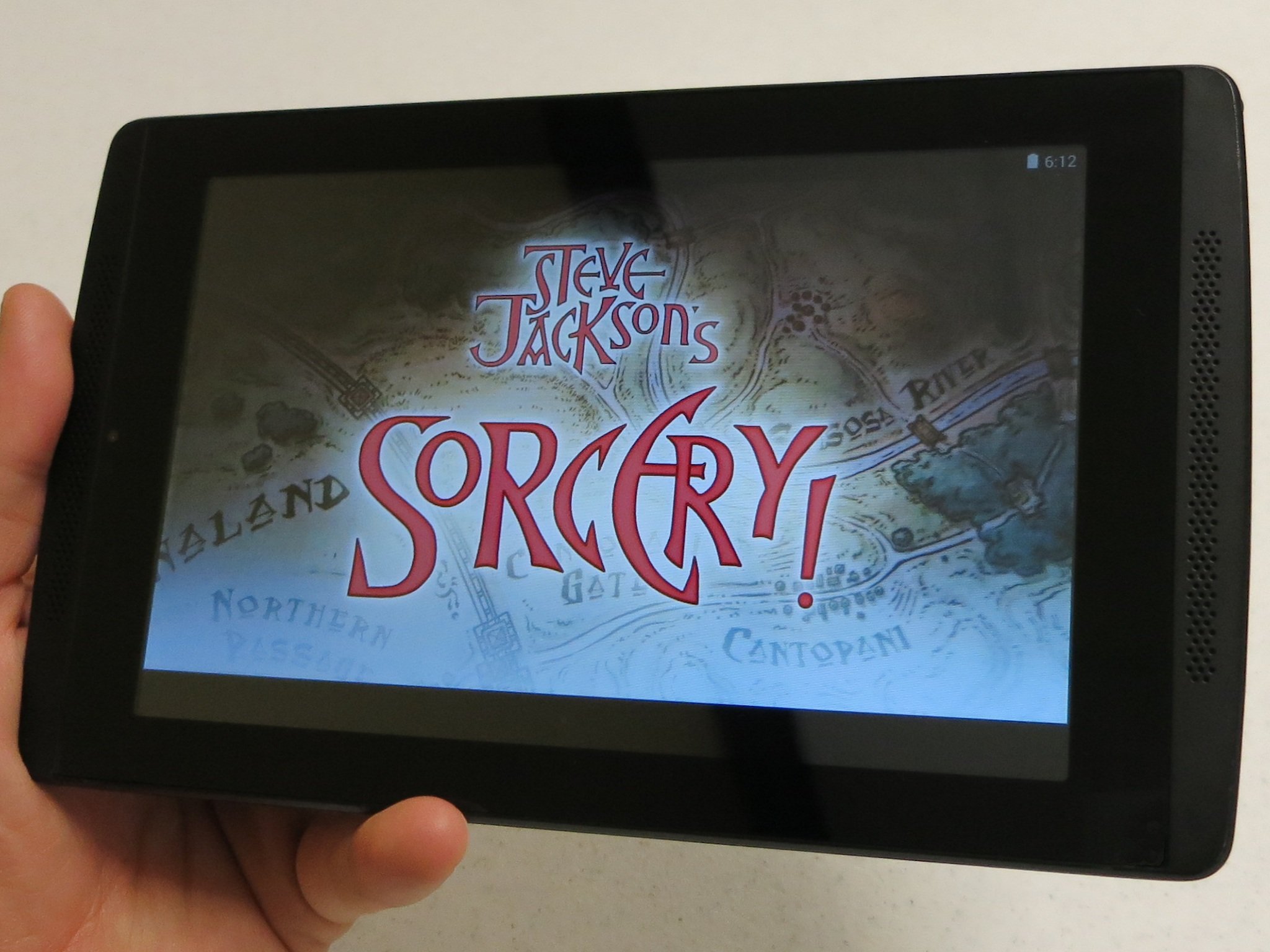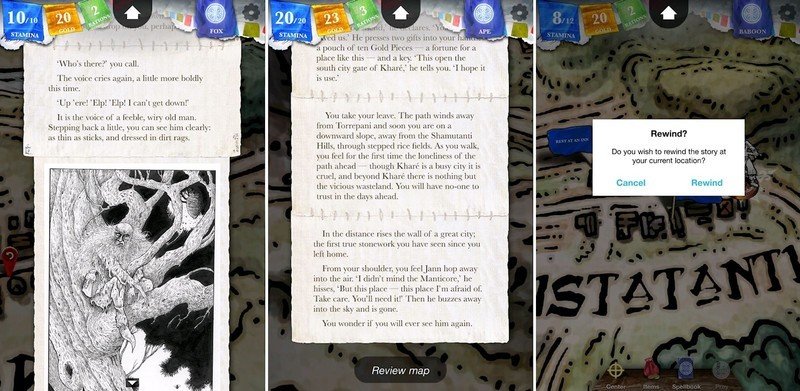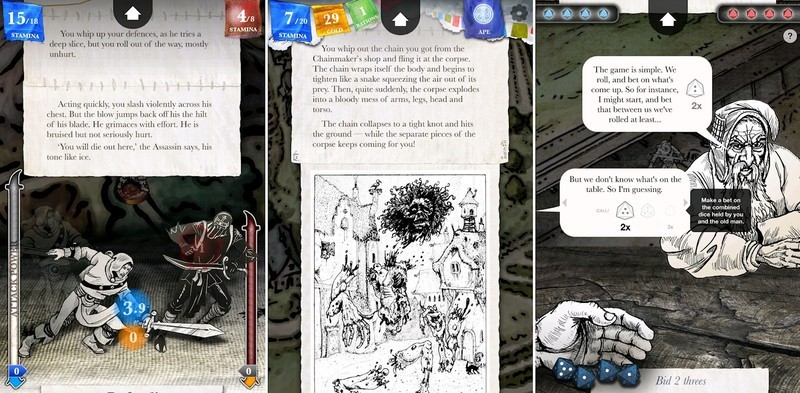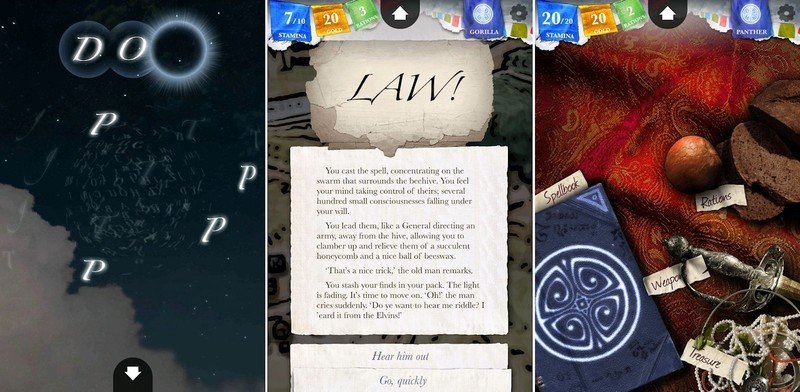Sorcery! 1 and 2 review

Back in the early eighties (before videogames became so ubiquitous), a game format emerged that bridged the gap between role-playing games and books. These "gamebooks" allowed readers to read along by themselves while making choices that would influence the outcome of the story. In the US, the "Choose Your Own Adventure" series entertained millions of young readers. Europe had the "Fighting Fantasy" series, created by Steve Jackson and Ian Livingstone.
Thanks to Cambridge-based developer Inkle Studios, Android gamers can now experience one of the most popular miniseries in the Fighting Fantasy lineup: Sorcery. Inkle has adapted two of the Sorcery books into full-fledged videogames, appropriately titled Steve Jackson's Sorcery! and Sorcery! 2. Players can enjoy either game individually, but both titles contribute to a larger fantasy role-playing tale.
An adventure of choice

Each game takes place on a large map beautifully illustrated by Mike Schley (Wizards of the Coast). After choosing between a male or female adventurer, players will travel from point to point on the map.
Instead of exploring locations in traditional videogame RPG-style, whatever happens to your character is communicated by pages from the books. You'll bring the locations and events to life with the power of imagination, not unlike the way pen-and-paper role-playing games are played.
Many of these events do have accompanying black-and-white illustrations by John Blanche. Unfortunately, the drawings can't be zoomed or magnified. That creates problems when playing in landscape orientation, in which they appear especially tiny. You'll want to play in portrait mode, as you would enjoy a traditional eBook.
You don't just follow along as the story happens to your character, of course. The real Sorcery gamebooks are highly interactive, and so is the videogame itself. You'll often choose from multiple actions or dialogue responses to any given situation. Sometimes these simply provide different paths to the same basic outcome (the illusion of choice). Other times they determine whether a fight occurs, which items you collect, and much more.
Be an expert in 5 minutes
Get the latest news from Android Central, your trusted companion in the world of Android
After finishing up with the current location, your adventurer will often get to choose between two or three destinations. These choices have the most impact on the game's outcome, as the story branches out in very different directions (and backtracking is usually not allowed). You might encounter an assassin in one location or simply find a treasure in another; you never know until you try.
Note that drawing a path from one location to another can be wonky sometimes. The hitboxes on each location seem to be a little smaller than they should. I often draw a line and find that it doesn't connect to the destination, forcing me to redraw. Inkle should buff the box sizes to make the line-drawing easier.
The many paths and outcomes lend Sorcery! a great deal of replay value. But players needn't start the whole game over just to find out which side has the greenest grass. Past locations are marked in red on the map. If you don't like what has happened to your hero, you can always rewind back to any of those locations and make different choices. Just be careful about rewinding too far, because you can't jump back forward.
Combat

From time to time during your adventure, you will do battle with other people and creatures. In contrast to the excellence of Sorcery's adventuring elements, the actual combat leaves something to be desired…
At the bottom of the screen you'll see the two combatants. You attack by sliding your character towards the enemy. The farther you slide the hero, the more attack points he or she will expend in the attack. Your enemy will attack simultaneously; whoever spent the most action points that turn will score the hit.
Once your action points run low, your attacks will become weak and nearly ineffectual. To restore some points and block an attack, just hit the defend button. You'll still take 1 Stamina (hit point) worth of damage by blocking. Each turn basically comes down to paper-rock-scissors since you never know what your opponent will do next. Coming out of a fight scot-free doesn't happen very often.
If you don't like the outcome of a fight, you can choose to replay it on the spot at the end of the battle. I wish we could restart mid-battle though. I often take a large blow early on and end up having to finish the fight even though it has already been blown. These fights are just too random and unenjoyable to me; a more traditional system would have been better.
Let's see you magish

Casting a spell just before the fight begins can reduce the frustration of battle. The hero can often use spells to affect non-combat situations as well. The downside is that spells cost stamina (hit points), so zapping a monster with lightning still amounts to taking a blow or two in the end.
In fitting with their titles, the two Sorcery games offer more than forty different spells to cast. You can browse these in the massive Spellbook, which was originally printed as its own separate companion book! The book recommends six spells as the most important to know, but all of them can come in handy depending on the situation.
To cast a spell, you simply input its three-letter code. Only certain letters are available in any given situation, so you can't just do crazy random things out of context. If I don't feel like looking up the spell that would seemingly help, I just try out the available letters and see what spells they make. I like how the spell system lets players choose between memorization and experimentation.
The two games
The overall goal of the Sorcery series is to recover the mystical Crown of Kings, an artifact that gives its wearer the power to influence the will of others. In the first game, players embark on the journey across the hills and plains of Analand. You might explore a goblin mine, meet a witch in the woods, enter or avoid a plague-infested town, and much more.
One playthrough of Part I probably spans four hours or so, concluding once the hero reaches the outskirts of the city of Kharé. You can then choose to upload your progress to the cloud. The game will generate a password that lets you recover your character in Part II, remembering all of his or her actions and possessions.
Sorcery 2 takes place entirely in Kharé – the city of traps. It turns out to be an absolutely massive city, much larger than the entire first game's realm. After entering the city, no one can leave. Only the lost words to a magic spell will open the northern passage and allow escape. The words were known to four city lords, all of whom have long been missing and/or deceased. Meanwhile, an army of goblins prepares to launch an attack on the city…
Steve Jackson's Sorcery and Sorcery 2 each sell separately for five dollars a pop. These games present an experience unlike any other (excluding a handful of Fighting Fantasy titles from rival developer Tin Man Games). Playing a gamebook-style videogame will be nostalgic for many of us, but pen-an-paper role-players will love the experience as well.
The two games make up the first half of a planned four-part series. Sorcery 3: The Seven Serpents is due out later this year. Let's hope Inkle doesn't keep Android gamers waiting too long for the story's conclusion.
- Sorcery! – $5.00 – Download now
- Sorcery! 2 – $5.00 – Download now

